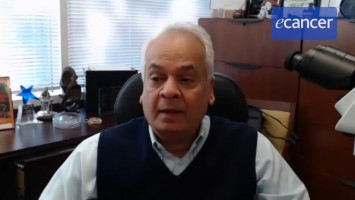Abemaciclib and fulvestrant show improved efficacy in HR+, HER2- advanced breast cancer compared to placebo and fulvestrant
Dr Kevin Kalinsky - Winship Cancer Institute, Georgia, USA
The postMONARCH study was a global phase III trial that was addressing the question of whether we should continue a CDK4/6 inhibitor upon progression and switch the endocrine therapy. We’d seen from other phase II trials some inconsistent findings in terms of the potential benefit of this approach and so the postMONARCH study was a trial of around 368 patients who were randomly assigned to fulvestrant plus abemaciclib versus fulvestrant plus placebo immediately after progression on an aromatase inhibitor and any CDK4/6 inhibitor.
What was the study design?
The study design was for patients, men and women, hormone receptor positive, HER2 negative, advanced disease. No prior chemotherapy in the advanced setting, no prior SERDs. 368 patients were randomly assigned to fulvestrant plus abemaciclib versus fulvestrant plus placebo after progression on any CDK4/6 inhibitor and endocrine therapy. The primary endpoint was investigator-assessed progression free survival.
What were the results?
We assumed a hazard ratio difference of 0.7 in the study. This was a statistically significant study so it met its primary endpoint. We saw an improvement of progression free survival with a hazard ratio of 0.73.
What is the significance of these results?
The study demonstrated that this is a strategy, continuing fulvestrant plus abemaciclib after progression on hormonal therapy and a CDK4/6 inhibitor. We saw a few things in the study. One, if we look at the overall results, the control arm, Faslodex alone, did better than what we’ve seen in other studies and this may be due to this is a very endocrine sensitive population. This was a true second-line study and patients were not allowed to have prior chemotherapy in the advanced setting. The other findings are we saw some well-represented subgroups, including those that did not have visceral metastasis and those that were on their prior CDK4/6 inhibitor for ≥ 12 months seemed to be subgroups that seemed to benefit in particular. For instance, we saw a 5-6 month median PFS benefit for those without visceral metastasis although there was a numerical benefit of about 2 months for those with visceral metastasis.
The other thing that’s notable is that in an exploratory analysis we looked at baseline circulating tumour DNA and regardless of the presence or absence of ESR1 mutations or PI3K alterations there was benefit with this strategy. So this has demonstrated this is a strategy for some patients, of course we have other second-line options as well, but this option is regardless of the presence of biomarker positivity.
What is next for this study?
For the next steps for the postMONARCH study we hope to report additional subgroup data including additional biomarker data from the postMONARCH study. So that should be presented hopefully at some additional congresses this year. I’ll also just mention that there are other studies that are looking at this approach that hopefully we should see the results of soon, including EMBER-3 which is a study of around 850 patients that randomly assigned patients to imlunestrant versus physician’s choice endocrine therapy versus imlunestrant plus abemaciclib. So more to come about this potential strategy.








